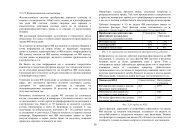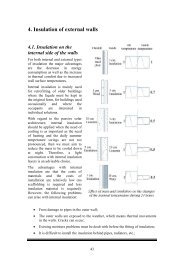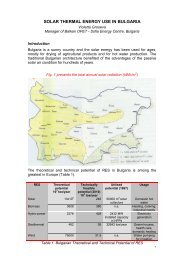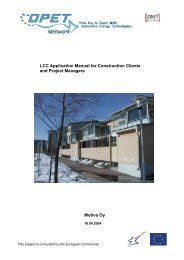Guidebook for Energy Efficiency in Municipalities
Guidebook for Energy Efficiency in Municipalities
Guidebook for Energy Efficiency in Municipalities
Create successful ePaper yourself
Turn your PDF publications into a flip-book with our unique Google optimized e-Paper software.
<strong>Energy</strong> efficiency and the build<strong>in</strong>g envelope<br />
T2<br />
Apart from reduc<strong>in</strong>g energy consumption, the benefits of an energy-efficient build<strong>in</strong>g<br />
envelope <strong>in</strong>clude:<br />
lower cost of air-condition<strong>in</strong>g plant, as smaller quantities of heat<strong>in</strong>g and cool<strong>in</strong>g are<br />
required at peak periods (often, the capital sav<strong>in</strong>gs on HVAC plant can almost pay <strong>for</strong><br />
the extra cost of <strong>in</strong>sulation and other energy-efficient features—be<strong>for</strong>e the value of<br />
ongo<strong>in</strong>g energy sav<strong>in</strong>gs is even considered);<br />
lower charges <strong>for</strong> peak energy demand;<br />
improved occupant com<strong>for</strong>t.<br />
The energy efficiency of an exist<strong>in</strong>g build<strong>in</strong>g envelope can be improved by a variety of<br />
measures. While this may not save on <strong>in</strong>vestment <strong>in</strong> heat<strong>in</strong>g and cool<strong>in</strong>g plant, it can still<br />
cut peak energy demand charges, reduce operat<strong>in</strong>g costs and improve occupant com<strong>for</strong>t.<br />
For example, where air-condition<strong>in</strong>g equipment is be<strong>in</strong>g converted to elim<strong>in</strong>ate the use of<br />
CFCs, the replacement refrigerants may have different properties, and this may reduce<br />
the cool<strong>in</strong>g capacity of the plant. Rather than <strong>in</strong>vest<strong>in</strong>g <strong>in</strong> extra equipment to compensate<br />
this, upgrad<strong>in</strong>g the energy efficiency of the build<strong>in</strong>g envelope is a good alternative, as this<br />
option also reduces peak capacity requirements and cuts ongo<strong>in</strong>g energy costs as well.<br />
Constra<strong>in</strong>ts to overcome<br />
Ef<strong>for</strong>ts to improve the thermal per<strong>for</strong>mance of a build<strong>in</strong>g are often treated as a low priority<br />
<strong>for</strong> a number of reasons:<br />
Build<strong>in</strong>g design is the responsibility of the architect, while eng<strong>in</strong>eers look after HVAC<br />
design (<strong>in</strong>clud<strong>in</strong>g calculation of heat<strong>in</strong>g and cool<strong>in</strong>g loads, which provides valuable<br />
<strong>in</strong><strong>for</strong>mation about which elements of the build<strong>in</strong>g envelope contribute most to heat<strong>in</strong>g<br />
and cool<strong>in</strong>g energy consumption and peak demand). Often communication between<br />
the two is poor. Appropriate contractual arrangements and/or use of a project<br />
manager or coord<strong>in</strong>ator can overcome this.<br />
HVAC designers are often paid a percentage of the cost of the HVAC system, so they<br />
have no <strong>in</strong>centive to help the architect reduce HVAC size and cost.<br />
Many designers believe that an energy-efficient build<strong>in</strong>g envelope may <strong>in</strong>crease<br />
energy consumption by trapp<strong>in</strong>g heat generated by lights, equipment, and people<br />
<strong>in</strong>side the build<strong>in</strong>g.<br />
<strong>Energy</strong> efficient build<strong>in</strong>g design is perceived to be expensive, but the appropriate<br />
orientation, siz<strong>in</strong>g, and selection of glaz<strong>in</strong>g can actually reduce envelope costs.<br />
Opportunities <strong>for</strong> sav<strong>in</strong>gs<br />
Sav<strong>in</strong>gs on HVAC operat<strong>in</strong>g costs (and greenhouse emissions) through energy-efficient<br />
build<strong>in</strong>g design can range from 20 to 50%.<br />
Glaz<strong>in</strong>g<br />
Up to a kilowatt of heat can enter a build<strong>in</strong>g through a square metre of clear glass<br />
exposed to direct sun, which is equivalent to switch<strong>in</strong>g on a s<strong>in</strong>gle-bar electric heater at<br />
the hottest time of the day. W<strong>in</strong>ter heat loss through each square metre of s<strong>in</strong>gle glaz<strong>in</strong>g<br />
is three times that through un<strong>in</strong>sulated wall, and more than 10 times the loss through a<br />
square metre of <strong>in</strong>sulated wall. This adds to peak electricity demand (often <strong>in</strong>curr<strong>in</strong>g extra<br />
demand charges), requires <strong>in</strong>creased HVAC system capacity, and creates glare and<br />
occupant discom<strong>for</strong>t.






